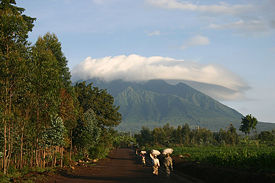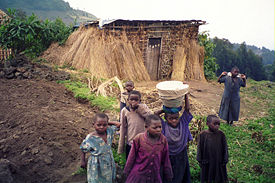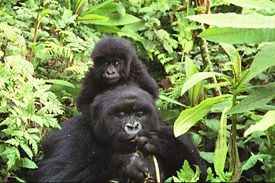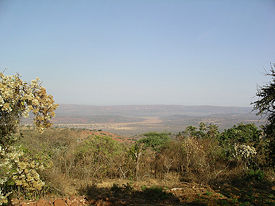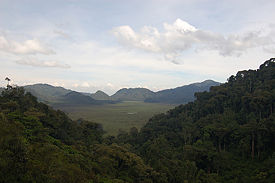Difference between revisions of "National parks of Rwanda" - New World Encyclopedia
Mary Anglin (talk | contribs) |
Svemir Brkic (talk | contribs) m (Fix category case) |
||
| (22 intermediate revisions by 3 users not shown) | |||
| Line 1: | Line 1: | ||
| − | {{Images OK}} | + | {{Copyedited}}{{Images OK}}{{Approved}} |
| − | [[Image:Volcanoes national park.jpg|thumb|275px|People on the road outside Volcanoes National Park, Rwanda Image by Derek Keats, Nov. 6, 2006.]] | + | [[Image:Volcanoes national park.jpg|thumb|275px|People on the road outside Volcanoes National Park, Rwanda. Image by Derek Keats, Nov. 6, 2006.]] |
| − | Rwanda is a small landlocked country in the [[African Great Lakes|Great Lakes]] region of east-central [[Africa]]. Its hilly terrain, which gives it the title "Land of a Thousand Hills," supports the densest population in [[sub-Saharan Africa]]. The country has a mostly | + | [[Rwanda]] is a small landlocked country in the [[African Great Lakes|Great Lakes]] region of east-central [[Africa]]. Its hilly terrain, which gives it the title "Land of a Thousand Hills," supports the densest population in [[sub-Saharan Africa]]. The country has a mostly [[mountain]]ous landscape that includes the volcanic [[Virunga Mountains|Virunga range]] in the northwest, home to what is estimated to be half of the world’s remaining mountain [[gorilla]]s. Its once extensive [[forest]]s are now concentrated in the western mountains and the Nyungwe forest, near Lake Kivu. |
| − | In 1978, the Wildlife Conservation Society began working in the nation, supporting studies of mountain gorilla [[ecology]] and the socio-economic context for conservation. From this sprang a program of mountain gorilla [[tourism]] which not only generates revenue and employment, but also helps protect the gorillas and their habitat. In the mid-1980s the organization expanded its focus to the Nyungwe Forest. The largest known mid-altitude forest of Africa, the area became a national park in 2004. <ref>''Wildlife Conservation Society'' | + | In 1978, the Wildlife Conservation Society began working in the nation, supporting studies of mountain gorilla [[ecology]] and the socio-economic context for conservation. From this sprang a program of mountain gorilla [[tourism]] which not only generates revenue and employment, but also helps protect the gorillas and their habitat. In the mid-1980s the organization expanded its focus to the Nyungwe Forest. The largest known mid-altitude forest of Africa, the area became a national park in 2004.<ref>''Wildlife Conservation Society'', [http://www.wcs.org/international/Africa/rwanda Saving Wildlife - Rwanda] Retrieved May 8, 2008.</ref> |
| − | + | {{toc}} | |
Rwanda has three [[National park]]s: the Akagera, the Nyungwe Forest, and the Volcanoes, which were created in the spirit of conservation and preservation of the natural environment. | Rwanda has three [[National park]]s: the Akagera, the Nyungwe Forest, and the Volcanoes, which were created in the spirit of conservation and preservation of the natural environment. | ||
| − | |||
| − | |||
| − | |||
| − | |||
| − | |||
| − | |||
| − | |||
| − | |||
| − | |||
| − | |||
| − | |||
| − | |||
| − | |||
| − | |||
| − | |||
| − | |||
| − | |||
| − | |||
| − | |||
| − | |||
| − | |||
| − | |||
| − | |||
| − | |||
| − | |||
| − | |||
| − | |||
| − | |||
| − | |||
| − | |||
==Volcanoes National Park== | ==Volcanoes National Park== | ||
| + | [[Image:Rwandan children at Volcans National Park.jpg|thumb|right|275px|Children on a farm near Volcanoes National Park.]] | ||
| + | '''Volcanoes National Park''' ([[French language|French]]: ''Parc National des Volcans'') lies in the northwestern part of the country and borders [[Virunga National Park]] in the [[Democratic Republic of Congo]] and [[Mgahinga Gorilla National Park]] in [[Uganda]]. This [[national park]] is known as a haven for the [[mountain gorilla]]. | ||
| − | [[ | + | Volcanoes National Park is home to five of the eight [[volcano]]es of the [[Virunga Mountains]] ([[Mount Karisimbi|Karisimbi]], [[Mount Bisoke|Bisoke]], [[Mount Muhabura|Muhabura]], [[Mount Gahinga|Gahinga]] and [[Mount Sabyinyo|Sabyinyo]]), which are covered in [[rainforest]] and [[bamboo]]. |
| − | + | The park, which was the base for [[Dian Fossey]], was the first established on the African continent, and is the smallest in Rwanda at 12,500 hectares (48 sq mi). | |
=== History === | === History === | ||
| − | + | The park was first gazetted in 1925 as a small area bounded by Karisimbi, Visoke and Mikeno, intended to protect the [[gorilla]]s from [[poaching]]. It was the first National Park to be created in [[Africa]]. Subsequently, in 1929, the borders of the park were extended further into [[Rwanda]] and into the [[Belgian Congo]], to form the Albert National Park, a huge area of 8090 km², run by the Belgian colonial authorities who were in charge of both colonies at that time. <ref name=Briggs>Philip Briggs, and Janice Booth, ''Rwanda: the Bradt travel guide'' (Bucks, England: Bradt Travel Guides, ISBN 1841620343), 171-172. </ref> | |
| − | The park was first gazetted in | ||
| − | After the Congo gained independence in | + | After the Congo gained independence in 1960, the park was split into two, and upon Rwandan independence in 1962 the new government agreed to maintain the park as a conservation and tourist area, despite the fact that the new republic was already suffering from overpopulation problems. The park was halved in area in 1969. |
| − | The park later became the base for the famous American naturalist [[Dian Fossey]] to carry out her research into the gorillas. She arrived in | + | The park later became the base for the famous American naturalist [[Dian Fossey]] to carry out her research into the gorillas. She arrived in 1967 and set up the [[Karisoke Research Centre]] between Karisimbi and Visoke. From that time on she spent most of her time in the park, and is widely credited with saving the gorillas from extinction by bringing their plight to the attention of the international community. She was murdered by unknown assailants at her home in 1985, a crime often attributed to the poachers she had spent her life fighting against.<ref name=Briggs/> Fossey's life later was portrayed on the big screen in the film ''Gorillas in the Mist'', named after her autobiography. She is buried in the park in a grave close to the research center, and amongst the gorillas which had become her life work. |
| − | The Volcanoes National Park became a battlefield during the [[Rwandan Civil War]], with the park headquarters being attacked in | + | The Volcanoes National Park became a battlefield during the [[Rwandan Civil War]], with the park headquarters being attacked in 1992. The research center was abandoned, and all tourist activities (including visiting the gorillas) were stopped. They did not resume again until 1999 when the area was deemed to be safe and under control. There have been occasional infiltrations by Rwandan rebels from the [[Democratic Forces for the Liberation of Rwanda]] in subsequent years, but these are always stopped quickly by the Rwandan army and there is thought to be no threat to [[tourism]] in the park. |
=== Flora and Fauna === | === Flora and Fauna === | ||
| + | [[Image:Gorilla mother and baby at Volcans National Park.jpg|thumb|right|275px|Gorilla mother and child in Volcanoes National Park]] | ||
==== Flora ==== | ==== Flora ==== | ||
| − | Vegetation varies considerably due to the large altitudinal range within the park. There is some lower montane forest (now mainly lost to agriculture). Between 2400 and 2500 m, there is ''Neoboutonia'' forest. From 2500 to 3200 m ''Arundinaria alpina'' (bamboo) forest occurs, covering about 30 | + | Vegetation varies considerably due to the large altitudinal range within the park. There is some lower [[montane forest]] (now mainly lost to [[agriculture]]). Between 2400 and 2500 m, there is ''Neoboutonia'' forest. From 2500 to 3200 m ''Arundinaria alpina'' ([[bamboo]]) forest occurs, covering about 30 percent of the park area. From 2600 to 3600 m, mainly on the more humid slopes in the south and west, is ''[[Hagenia]]-Hypericum'' forest, which covers about 30 percent of the park. This is one of the largest forests in Africa with ''Hagenia abyssinica''. The vegetation from 3500 to 4200 m is characterized by ''Lobelia wollastonii'', ''L. lanurensis'', and ''Senecio erici-rosenii'' and covers about 25 percent of the park. From 4300 to 4500 m grassland occurs. Secondary thicket, meadows, [[marsh]]es, [[swamp]]s and small [[lake]]s also occur, but their total area is relatively small. |
==== Fauna ==== | ==== Fauna ==== | ||
| − | The park is best known for | + | The park is best known for its population of [[Mountain Gorilla]]s ''(Gorilla beringei beringei)''. Other [[mammal]]s include: golden [[monkey]] ''(Cercopithecus mitis kandti)'', black-fronted duiker ''(Cephalophus niger)'', [[buffalo]] ''(Syncerus caffer)'', [[Spotted Hyena]] ''(Crocuta crocuta)'' and bushbuck ''(Tragelaphus scriptus)''. There are also reported to be some [[elephant]]s in the park, though these are now very rare. There are 178 recorded [[bird]] species, with at least 13 [[species]] and 16 subspecies endemic to the Virunga and Ruwenzori Mountains.<ref> ''United Nations Environment Programme World Conservation Monitoring Centre'', [http://www.unep-wcmc.org/protected_areas/data/sample/0360p.htm Volcanoes National Park Page] Retrieved May 8, 2008. </ref> |
=== Tourism in the park === | === Tourism in the park === | ||
| − | + | The Rwanda tourist board, ORTPN, runs several activities for tourists, including:<ref> ''Rwanda Tourism Board'', [http://www.rwandatourism.com Discover a New African Dawn] Retrieved May 8, 2008. </ref> | |
| − | The Rwanda tourist board, ORTPN, runs several activities for tourists, including:<ref>[http://www.rwandatourism.com | ||
* Gorilla visits - there are four habituated groups open to tourists, allowing for a total of 32 permits per day. Tourists spend an hour with the gorillas. | * Gorilla visits - there are four habituated groups open to tourists, allowing for a total of 32 permits per day. Tourists spend an hour with the gorillas. | ||
* Golden monkey visits. | * Golden monkey visits. | ||
| Line 70: | Line 41: | ||
* Tour of the lakes and caves. | * Tour of the lakes and caves. | ||
* Visiting the tomb of Dian Fossey. | * Visiting the tomb of Dian Fossey. | ||
| − | The majority of revenue from tourism goes towards maintaining the park and conserving | + | The majority of revenue from tourism goes towards maintaining the park and conserving wildlife. The remainder goes to the government and approximately ten percent is contributed to projects in the area which benefit the local people. |
| + | |||
| + | ==Akagera National Park== | ||
| + | [[Image:Akagera.jpg|thumb|275px|right|Akagera National Park, March 2005.]] | ||
| + | |||
| + | The '''Akagera National Park''' ([[French language|French]]: ''Parc National de l'Akagera'') is situated at lower altitudes in the northeast part of the country, on the Tanzanian border. It was founded in 1934 to protect animals in three [[ecoregion]]s: [[Savanna|savannah]], [[mountain]] and [[swamp]]. The beautiful [[Lake Shakani]] and [[Lake Ihema]] are within the park's borders. Much of the savannah area of the park was settled in the late 1990s by former [[refugee]]s returning after the end of the [[Rwandan Civil War]], but the other regions remain relatively remote. Animals which fled during the upheavals are now returning. The park is named for the [[Kagera River]] which flows through it. | ||
| + | |||
| + | The Akagera covers 90,000 hectares (347.5 sq mi), making it the second largest national park in Rwanda. Founded in 1934, it was Rwanda's second national park to be established. | ||
| + | |||
| + | ===Flora and fauna=== | ||
| + | Akagera National Park, in contrast to much of the rest of the country, is dominated by swamps and lakes which follow the meandering course of the Akagera River, the most remote source of the [[Nile River|Nile]]. | ||
| + | The land within this park is considered archetypal African savannah landscape of tangled acacia woodland interspersed with open grassland. | ||
| + | |||
| + | Akagera is essentially big game country. There are herds of [[elephant]], [[buffalo]], [[giraffe]], and [[zebra]], along with [[leopard]]s, spotted [[hyena]]s and [[lion]]s. The park is home to more than a dozen types of antelope, most commonly the chestnut-coated impala, as well as the diminutive oribi and secretive bushbuck, the world's largest antelope, the eland and the ungainly tsessebe. | ||
| + | |||
| + | The park's waters are home to hippopotami - often gathered in pods of 50 or more - and crocodiles. There are a recorded 425 species of [[bird]] life. Some of Africa's densest concentrations of waterbirds along the park's shores, while the marshes provide habitat for a number of endangered species, such as the papyrus gonolek and the shoe-bill, the latter possibly the most eagerly sought of all African birds.<ref>''Goway'', [http://www.goway.com/africa/rwanda/rw_nat_parks.html Rwanda National Parks] Retrieved May 8, 2008.</ref> | ||
| + | |||
| + | ==Nyungwe Forest National Park == | ||
| + | [[Image:Nyungwe.jpg|275px|thumb|Nyungwe National Park in Rwanda. Photo by John and Mel Kots, December 12, 2005.]] | ||
| + | '''Nyungwe Forest National Park''' is the most recent of Rwanda's national parks, established in 2004. It is in the southwestern part of the country, located south of [[Lake Kivu]] on the border with [[Burundi]]. The park contains the largest block of montane forest in [[East Africa|East]] or [[Central Africa]], and one of the most ancient, dating back to before the last Ice Age. | ||
| + | With great floral diversity, the [[forest]] is home to more than 200 different types of [[tree]]s and a myriad of flowering plants. [[Rainforest]], [[bamboo]], [[grassland]], [[swamp]]s, and [[bog]]s complete the area. [[Mount Bigugu]] is located within the park borders. | ||
| + | |||
| + | The Nyungwe is the largest of Rwanda's national parks, at 97,000 hectares (374.5 sq mi). | ||
| + | |||
| + | ===Animal life=== | ||
| + | Nyungwe has a wide diversity of animal species, making it a priority for conservation in Africa. The forest is situated in a region where several large-scale [[biogeographical zone]]s meet and the variety of terrestrial [[biome]]s provide a great span of [[microhabitat]]s for many different species of plants and animals. | ||
| + | |||
| + | The park contains 13 different [[primate]] species (25 percent of Africa's total), 275 [[bird]] species, 1,068 [[plant]] species, 85 [[mammal]] species, 32 [[amphibia]]n and 38 [[reptile]] species. Many of these animals are [[restricted-range species]] that are only found in the [[Albertine Rift]] [[ecoregion]] in Africa. In fact, the number of endemic species found here is greater than in any other forest in the Albertine Rift that has been surveyed. | ||
| + | |||
| + | [[Carnivore]]s in the park include [[leopard]], [[golden cat]], [[serval cat]], side stripped [[jackal]], [[Genet]], [[African civet]], slender and marsh [[mongoose]]. There are three species of horned [[chameleon]]s and 120 species of [[Butterfly|butterflies]]. | ||
| + | |||
| + | ===Primate species=== | ||
| + | *[[Common Chimpanzee]] ''(Pan troglodytes)'' | ||
| + | *[[Adolf Friedrich's Angola Colobus]] ''(Colobus angolensis ruwenzori)'' | ||
| + | *[[L'Hoest's Monkey]] (''Cercopithecus l'hoesti'') | ||
| + | *[[Silver Monkey]] ''(Cercopithecus doggetti)'' | ||
| + | *[[Golden Monkey]] ''(Cercopithecus kandti)'' | ||
| + | *[[Hamlyn's Monkey]] ''(Cercopithecus hamlyni)'' | ||
| + | *[[Red-tailed Monkey]] ''(Cercopithecus ascanius)'' | ||
| + | *[[Dent's Mona Monkey]] ''(Cercopithecus denti)'' | ||
| + | *[[Vervet Monkey]] ''(Chlorocebus pygerythrus)'' | ||
| + | *[[Olive Baboon]] ''(Papio anubis)'' | ||
| + | *[[Grey-cheeked Mangabey]] ''(Lophocebus albigena)'' | ||
==Notes== | ==Notes== | ||
| Line 77: | Line 90: | ||
==References== | ==References== | ||
| − | * | + | * ''NASA Earth Observatory''. [http://earthobservatory.nasa.gov/Newsroom/NewImages/images.php3?img_id=16486 Nyungwe National Park, Rwanda] Retrieved May 8, 2008. |
| − | + | * ''Rwanda Tourism Board''. [http://www.rwandatourism.com Discover a New African Dawn] Retrieved May 8, 2008. | |
| − | * | + | * ''United Nations Environment Programme World Conservation Monitoring Centre.'' [http://www.unep-wcmc.org/protected_areas/data/sample/0360p.htm Volcanoes National Park Page] Retrieved May 8, 2008. |
| − | + | * Vande weghe, Jean Pierre and Thérèse Abandibakobwa, José Kalpers a.o. Photography by Philippe Dejace. Translated by Alicia L. Spruijt-Ray. 1990. ''Akagera: Land of water, grass and fire''. World Wildlife Fund for Nature. Brussels, Belgium. | |
| − | + | * ''Wildlife Conservation Society''. [http://www.wcs.org/international/Africa/rwanda/akageranationalpark?preview=&psid=&ph=class%252525252525252525253DAWC-14877272 Nyungwe National Park] Retrieved May 8, 2008. | |
| − | |||
| − | |||
| − | *[http://www.unep-wcmc.org/protected_areas/data/sample/0360p.htm Volcanoes National Park | ||
| − | * | ||
| − | |||
| − | * [http://www.wcs.org/international/Africa/rwanda/akageranationalpark?preview=&psid=&ph=class%252525252525252525253DAWC-14877272 | ||
| − | |||
{{credit|Akagera_National_Park|205311246|Nyungwe_Forest|209097932|Volcanoes_National_Park|202844166}} | {{credit|Akagera_National_Park|205311246|Nyungwe_Forest|209097932|Volcanoes_National_Park|202844166}} | ||
[[Category:Geography]] | [[Category:Geography]] | ||
[[Category:Africa]] | [[Category:Africa]] | ||
| − | [[Category:National | + | [[Category:National Parks]] |
Latest revision as of 02:28, 19 December 2022
Rwanda is a small landlocked country in the Great Lakes region of east-central Africa. Its hilly terrain, which gives it the title "Land of a Thousand Hills," supports the densest population in sub-Saharan Africa. The country has a mostly mountainous landscape that includes the volcanic Virunga range in the northwest, home to what is estimated to be half of the world’s remaining mountain gorillas. Its once extensive forests are now concentrated in the western mountains and the Nyungwe forest, near Lake Kivu.
In 1978, the Wildlife Conservation Society began working in the nation, supporting studies of mountain gorilla ecology and the socio-economic context for conservation. From this sprang a program of mountain gorilla tourism which not only generates revenue and employment, but also helps protect the gorillas and their habitat. In the mid-1980s the organization expanded its focus to the Nyungwe Forest. The largest known mid-altitude forest of Africa, the area became a national park in 2004.[1]
Rwanda has three National parks: the Akagera, the Nyungwe Forest, and the Volcanoes, which were created in the spirit of conservation and preservation of the natural environment.
Volcanoes National Park
Volcanoes National Park (French: Parc National des Volcans) lies in the northwestern part of the country and borders Virunga National Park in the Democratic Republic of Congo and Mgahinga Gorilla National Park in Uganda. This national park is known as a haven for the mountain gorilla.
Volcanoes National Park is home to five of the eight volcanoes of the Virunga Mountains (Karisimbi, Bisoke, Muhabura, Gahinga and Sabyinyo), which are covered in rainforest and bamboo.
The park, which was the base for Dian Fossey, was the first established on the African continent, and is the smallest in Rwanda at 12,500 hectares (48 sq mi).
History
The park was first gazetted in 1925 as a small area bounded by Karisimbi, Visoke and Mikeno, intended to protect the gorillas from poaching. It was the first National Park to be created in Africa. Subsequently, in 1929, the borders of the park were extended further into Rwanda and into the Belgian Congo, to form the Albert National Park, a huge area of 8090 km², run by the Belgian colonial authorities who were in charge of both colonies at that time. [2]
After the Congo gained independence in 1960, the park was split into two, and upon Rwandan independence in 1962 the new government agreed to maintain the park as a conservation and tourist area, despite the fact that the new republic was already suffering from overpopulation problems. The park was halved in area in 1969.
The park later became the base for the famous American naturalist Dian Fossey to carry out her research into the gorillas. She arrived in 1967 and set up the Karisoke Research Centre between Karisimbi and Visoke. From that time on she spent most of her time in the park, and is widely credited with saving the gorillas from extinction by bringing their plight to the attention of the international community. She was murdered by unknown assailants at her home in 1985, a crime often attributed to the poachers she had spent her life fighting against.[2] Fossey's life later was portrayed on the big screen in the film Gorillas in the Mist, named after her autobiography. She is buried in the park in a grave close to the research center, and amongst the gorillas which had become her life work.
The Volcanoes National Park became a battlefield during the Rwandan Civil War, with the park headquarters being attacked in 1992. The research center was abandoned, and all tourist activities (including visiting the gorillas) were stopped. They did not resume again until 1999 when the area was deemed to be safe and under control. There have been occasional infiltrations by Rwandan rebels from the Democratic Forces for the Liberation of Rwanda in subsequent years, but these are always stopped quickly by the Rwandan army and there is thought to be no threat to tourism in the park.
Flora and Fauna
Flora
Vegetation varies considerably due to the large altitudinal range within the park. There is some lower montane forest (now mainly lost to agriculture). Between 2400 and 2500 m, there is Neoboutonia forest. From 2500 to 3200 m Arundinaria alpina (bamboo) forest occurs, covering about 30 percent of the park area. From 2600 to 3600 m, mainly on the more humid slopes in the south and west, is Hagenia-Hypericum forest, which covers about 30 percent of the park. This is one of the largest forests in Africa with Hagenia abyssinica. The vegetation from 3500 to 4200 m is characterized by Lobelia wollastonii, L. lanurensis, and Senecio erici-rosenii and covers about 25 percent of the park. From 4300 to 4500 m grassland occurs. Secondary thicket, meadows, marshes, swamps and small lakes also occur, but their total area is relatively small.
Fauna
The park is best known for its population of Mountain Gorillas (Gorilla beringei beringei). Other mammals include: golden monkey (Cercopithecus mitis kandti), black-fronted duiker (Cephalophus niger), buffalo (Syncerus caffer), Spotted Hyena (Crocuta crocuta) and bushbuck (Tragelaphus scriptus). There are also reported to be some elephants in the park, though these are now very rare. There are 178 recorded bird species, with at least 13 species and 16 subspecies endemic to the Virunga and Ruwenzori Mountains.[3]
Tourism in the park
The Rwanda tourist board, ORTPN, runs several activities for tourists, including:[4]
- Gorilla visits - there are four habituated groups open to tourists, allowing for a total of 32 permits per day. Tourists spend an hour with the gorillas.
- Golden monkey visits.
- Climbing of Karisimbi volcano - this is a two day trek with overnight camping at an altitude of 3,800 m.
- Climbing of Bisoke volcano - one day.
- Tour of the lakes and caves.
- Visiting the tomb of Dian Fossey.
The majority of revenue from tourism goes towards maintaining the park and conserving wildlife. The remainder goes to the government and approximately ten percent is contributed to projects in the area which benefit the local people.
Akagera National Park
The Akagera National Park (French: Parc National de l'Akagera) is situated at lower altitudes in the northeast part of the country, on the Tanzanian border. It was founded in 1934 to protect animals in three ecoregions: savannah, mountain and swamp. The beautiful Lake Shakani and Lake Ihema are within the park's borders. Much of the savannah area of the park was settled in the late 1990s by former refugees returning after the end of the Rwandan Civil War, but the other regions remain relatively remote. Animals which fled during the upheavals are now returning. The park is named for the Kagera River which flows through it.
The Akagera covers 90,000 hectares (347.5 sq mi), making it the second largest national park in Rwanda. Founded in 1934, it was Rwanda's second national park to be established.
Flora and fauna
Akagera National Park, in contrast to much of the rest of the country, is dominated by swamps and lakes which follow the meandering course of the Akagera River, the most remote source of the Nile. The land within this park is considered archetypal African savannah landscape of tangled acacia woodland interspersed with open grassland.
Akagera is essentially big game country. There are herds of elephant, buffalo, giraffe, and zebra, along with leopards, spotted hyenas and lions. The park is home to more than a dozen types of antelope, most commonly the chestnut-coated impala, as well as the diminutive oribi and secretive bushbuck, the world's largest antelope, the eland and the ungainly tsessebe.
The park's waters are home to hippopotami - often gathered in pods of 50 or more - and crocodiles. There are a recorded 425 species of bird life. Some of Africa's densest concentrations of waterbirds along the park's shores, while the marshes provide habitat for a number of endangered species, such as the papyrus gonolek and the shoe-bill, the latter possibly the most eagerly sought of all African birds.[5]
Nyungwe Forest National Park
Nyungwe Forest National Park is the most recent of Rwanda's national parks, established in 2004. It is in the southwestern part of the country, located south of Lake Kivu on the border with Burundi. The park contains the largest block of montane forest in East or Central Africa, and one of the most ancient, dating back to before the last Ice Age.
With great floral diversity, the forest is home to more than 200 different types of trees and a myriad of flowering plants. Rainforest, bamboo, grassland, swamps, and bogs complete the area. Mount Bigugu is located within the park borders.
The Nyungwe is the largest of Rwanda's national parks, at 97,000 hectares (374.5 sq mi).
Animal life
Nyungwe has a wide diversity of animal species, making it a priority for conservation in Africa. The forest is situated in a region where several large-scale biogeographical zones meet and the variety of terrestrial biomes provide a great span of microhabitats for many different species of plants and animals.
The park contains 13 different primate species (25 percent of Africa's total), 275 bird species, 1,068 plant species, 85 mammal species, 32 amphibian and 38 reptile species. Many of these animals are restricted-range species that are only found in the Albertine Rift ecoregion in Africa. In fact, the number of endemic species found here is greater than in any other forest in the Albertine Rift that has been surveyed.
Carnivores in the park include leopard, golden cat, serval cat, side stripped jackal, Genet, African civet, slender and marsh mongoose. There are three species of horned chameleons and 120 species of butterflies.
Primate species
- Common Chimpanzee (Pan troglodytes)
- Adolf Friedrich's Angola Colobus (Colobus angolensis ruwenzori)
- L'Hoest's Monkey (Cercopithecus l'hoesti)
- Silver Monkey (Cercopithecus doggetti)
- Golden Monkey (Cercopithecus kandti)
- Hamlyn's Monkey (Cercopithecus hamlyni)
- Red-tailed Monkey (Cercopithecus ascanius)
- Dent's Mona Monkey (Cercopithecus denti)
- Vervet Monkey (Chlorocebus pygerythrus)
- Olive Baboon (Papio anubis)
- Grey-cheeked Mangabey (Lophocebus albigena)
Notes
- ↑ Wildlife Conservation Society, Saving Wildlife - Rwanda Retrieved May 8, 2008.
- ↑ 2.0 2.1 Philip Briggs, and Janice Booth, Rwanda: the Bradt travel guide (Bucks, England: Bradt Travel Guides, ISBN 1841620343), 171-172.
- ↑ United Nations Environment Programme World Conservation Monitoring Centre, Volcanoes National Park Page Retrieved May 8, 2008.
- ↑ Rwanda Tourism Board, Discover a New African Dawn Retrieved May 8, 2008.
- ↑ Goway, Rwanda National Parks Retrieved May 8, 2008.
ReferencesISBN links support NWE through referral fees
- NASA Earth Observatory. Nyungwe National Park, Rwanda Retrieved May 8, 2008.
- Rwanda Tourism Board. Discover a New African Dawn Retrieved May 8, 2008.
- United Nations Environment Programme World Conservation Monitoring Centre. Volcanoes National Park Page Retrieved May 8, 2008.
- Vande weghe, Jean Pierre and Thérèse Abandibakobwa, José Kalpers a.o. Photography by Philippe Dejace. Translated by Alicia L. Spruijt-Ray. 1990. Akagera: Land of water, grass and fire. World Wildlife Fund for Nature. Brussels, Belgium.
- Wildlife Conservation Society. Nyungwe National Park Retrieved May 8, 2008.
Credits
New World Encyclopedia writers and editors rewrote and completed the Wikipedia article in accordance with New World Encyclopedia standards. This article abides by terms of the Creative Commons CC-by-sa 3.0 License (CC-by-sa), which may be used and disseminated with proper attribution. Credit is due under the terms of this license that can reference both the New World Encyclopedia contributors and the selfless volunteer contributors of the Wikimedia Foundation. To cite this article click here for a list of acceptable citing formats.The history of earlier contributions by wikipedians is accessible to researchers here:
The history of this article since it was imported to New World Encyclopedia:
Note: Some restrictions may apply to use of individual images which are separately licensed.
